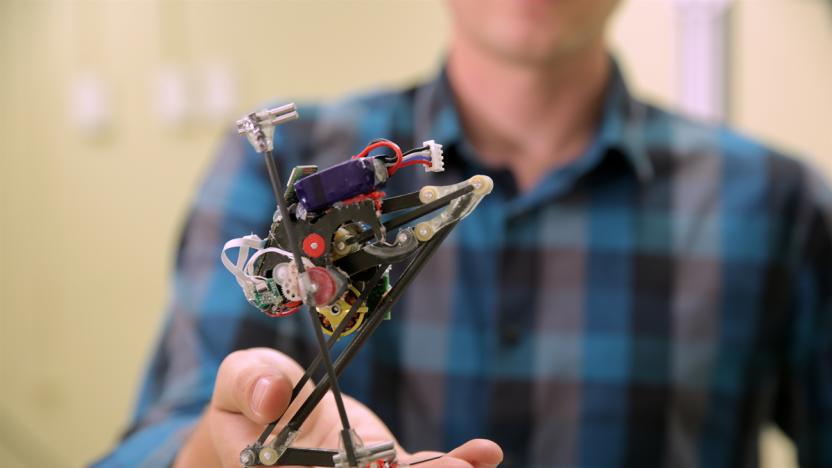jumpingrobot
Latest

ICYMI: Using brain power to move a game character
try{document.getElementById("aol-cms-player-1").style.display="none";}catch(e){}Today on In Case You Missed It: University of Washington researchers were able to use a magnetic coil at the base of test subjects skulls to watch them play a simplified 2D computer game with just the power of their thoughts. Meanwhile UC Berkeley researchers built a small robot called the SALTO that weighs only 100 grams but is based on the jumping abilities of kangaroos. Google just created a bit of fun on its Twitter account, where users can tweet at the search engine with emojis, then get a response from the account show the nearest location for whatever taco or burger you need asap. 'Cause typing into a search bar is passé now, I guess. For your reminder that: Scientists, they're just like us!-- be sure to check out CERN's silly Mannequin Challenge. As always, please share any interesting tech or science videos you find by using the #ICYMI hashtag on Twitter for @mskerryd.

UC Berkeley researchers built a wall-jumping robot
Meet SALTO: a powerful new wall-jumping robot built by researchers at UC Berkeley. According to SALTO's makers, the diminutive, one-legged hopper not only has the "highest robotic vertical jumping agility ever recorded," but also the ability to link together multiple jumps in quick succession.

Chinese microbot walks on water, skims the surface of insect-inspired design
Bugs are creepy. You don't need to be an entomophobe to empathize with that sentiment. But bugs are also inspiring -- to researchers in China, that is. Taking a cue from nature, a team of engineers from the country's School of Chemical Engineering and Technology have devised a microbot weighing just 0.02 lbs (11 grams) that can repeatedly jump across the surface of water without tanking. How'd they do it? Well, by using a highly repellent foam coating, the strider-like bot's legs are able to stay afloat with every 5.5 inch (14 cm) leap it makes, buffering the force that would normally plunge it below the H20. The creation of this hydrophobic mini-insectoborg isn't exactly the first of its kind, other aquatic gliders have come before, but this itty bitty fella's the first to successfully and repeatedly hop along an aqueous top. Unfortunately, there's no video demo for you to feast your eyes upon, so you'll just have to take our word for it.

Video: Precision Urban Hopper leaps over fences, makes enemies cringe
It's only been a few months since we heard from the whiz kids over at Boston Dynamics, and honestly, we've been waiting on pins and needles to see what miracle would emerge from its labs next. Said outfit has just been awarded a contract by Sandia to build the next generation of the Precision Urban Hopper, which will be a four-wheeled jumping robot that can navigate autonomously. When it rolls into battle, it'll also be equipped with a single jumping leg, giving it the ability to hop over fences, giant humans, Gort or anything else that's 25 feet tall. Best of all, testing and delivery is scheduled for late 2010, so if you were planning on getting on our bad side, you should probably have a look at the video past the break. Chances are you'll be second guessing that urge.[Via TG Daily]%Gallery-72917%

Video: Robohopper gets wings, Icarus complex
Remember the tiny 5cm robot grasshopper that could leap like a superhero but had trouble landing its, um, landings? Well, it still hasn't figured out those basics, but its Swiss developers are already marching ahead with plans to endow it with a pair of wings and light awareness. Now described as a self-deploying microglider, the wannabe locust will be able to identify light sources and fly toward them, an act known as phototaxis, which will make it about as intelligent as your garden variety moth. All the same, you can't stick a camera on a moth and use it to search disaster areas for survivors ... or can you? Videos of the underlying tech can be found after the break. [Via Bot Junkie]

Robot that can jump twenty-five feet in the air coming to the US military
Boston Dynamics -- which previously made a robot called the BigDog -- has been enlisted by Sandia National Laboratories (a US government-funded lab) and DARPA to make a new, hopping robot. Called the Precision Urban Hopper, the robot's goal will be to be capable of jumping over large obstacles in city combat situations. It will boast one extremely tough leg to assist it, in addition to its four wheels. The Hopper is supposedly going to be able to jump 25 feet in the air once completed. So far, only a very small prototype (pictured above) is finished, but Boston Dynamics is due to present its next model sometime during 2010.

Grasshoppper "robot" sets new high-jump record
While it doesn't exactly boast all that many robot-like characteristics, this grasshopper-inspired bot from the Swiss Federal Institute of Technology is apparently enough of one to lay claim to the robot high-jump record, which it was able to capture handily by jumping 27 times its own height. That was done with the aid of a motor originally designed to power the vibration unit of a pager which, in this case, winds up two metal springs that eventually release and spring the 5-centimeter tall bot into the air. What's more, while it doesn't have any means of directing itself or even landing on its feet just yet, the researchers behind the bot eventually hope to add some solar panels, sensors, and a microprocessor to it, which they say could one day allow swarms of 'em to explore disaster areas, or even hop their way around the surface of other planets. Head on past the break for a video of it doing its thing.



